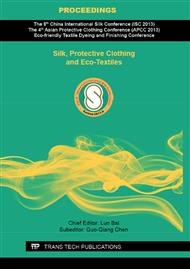p.36
p.39
p.43
p.48
p.57
p.62
p.67
p.72
p.79
Analysis of Cocoon and Silk Quality of Trimolter Silkworms Induced by Anti-Juvenile Hormone
Abstract:
Trimolter silk fiber has special economic value and bright prospect in terms of developing the distinctive silk textile of high quality. In this research, the trimolters were induced by AJH (Jinlu inducer) using two races of silkworms (Qiufeng×Baiyu and Liangguang NO.2) as materials, and their cocoon and silk quality differences were investigated with single cocoon reeling test The results showed that the cocoon filament denier were different because of silkworm races and treatment periods The cocoon filament deniers from the controls, 3rd instar and 4th instar treatment groups of Liangguang NO.2 were 2.64 D, 1.45D and 0.78 D, while the cocoon filament deniers of Qiufeng×Baiyu were 2.47 D, 1.75 D and 1.01 D, respectively. Compared with the controls, the breakage strength of silk fiber from 3rd instar treatment groups of Qiufeng×Baiyu and Liangguang NO.2 enhanced 109.6 % and 145.2 %, on the contrary, that of 4th instar treatment groups declined to 70.3 % and 43.6 %. Additionally, sericin tended to decrease after the treatment of AJH. These results showed that fine filament silk with high quality could be produced in the early stage of 3rd instar induced by AJH, which was superior to that of tetramolters, and the super fine filament silk can be produced in the stage of 4th instar induced by AJH.
Info:
Periodical:
Pages:
57-61
Citation:
Online since:
September 2013
Authors:
Keywords:
Price:
Сopyright:
© 2013 Trans Tech Publications Ltd. All Rights Reserved
Share:
Citation:


